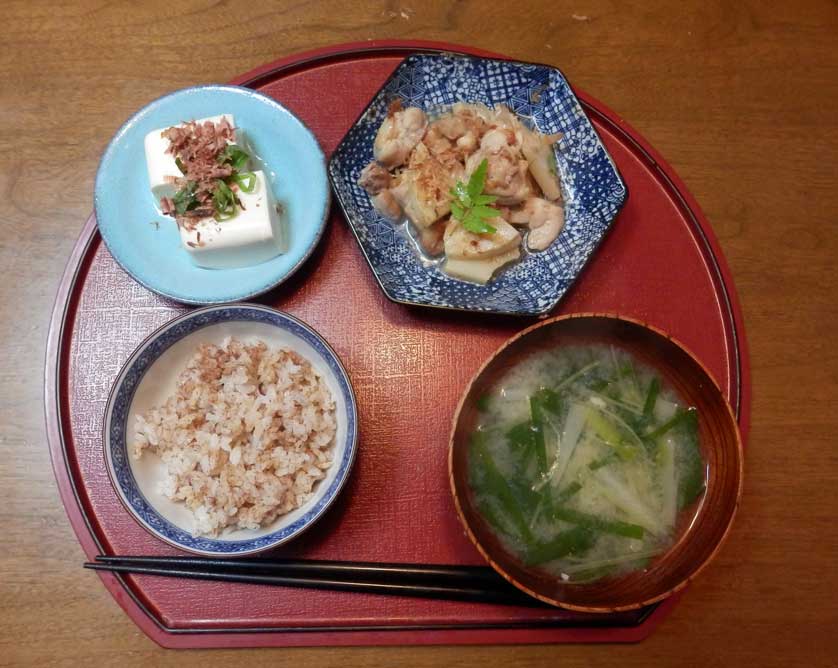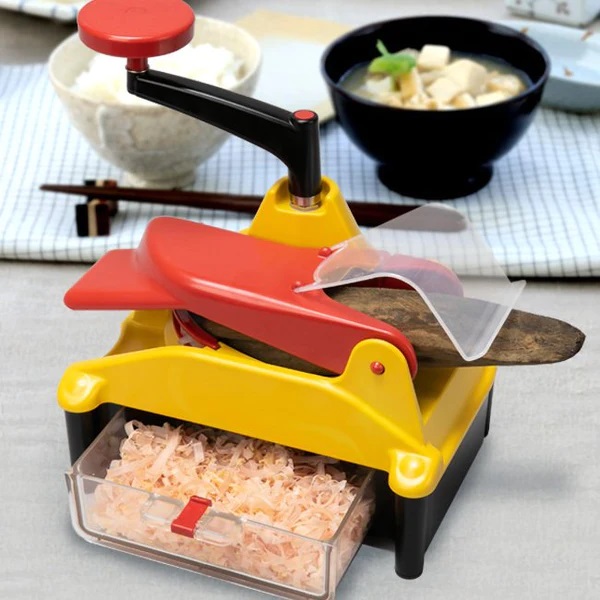Bonito Flakes in the Kitchen: Katsuobushi and the Katsuobushi Kezuriki 鰹節と鰹節削り器
 |
| Katsuobushi fillet and katsuobushi kezuriki |
Remember the first time you were served okonomiyaki (Japanese pancakes) in one of those dark, dingy, tiny but homely restaurants in Osaka? The first time you received a boat of takoyaki (wheat batter balls containing a piece of octopus)? Did you wonder what those wildly fluttering flakes on top of the dish? Those flakes almost seem to have a life of their own! It's the heat of the dishes underneath that makes them vibrate.
Those flakes are called katsuobushi and you encounter them in Japan quite frequently and in many different ways. They are used as soup stock, mixed with rice in onigiri rice balls and as topping on an endless variety of dishes ranging from tofu to soba noodles to meat (especially chicken), more recent recipes even include them as toppings on avocado and other imported foods.
 |
| Katsuobushi fillets |
What is Katsuobushi?
Now, what are those katsuobushi? Roughly translated, katsuobushi means dried bonito flakes. Katsuo is the Japanese name for the skipjack bonito, a fish belonging to the tuna family.
The best meat of those fish, usually caught in the waters surrounding southern Japan, is filleted by hand and knife. Work that needs quite some skill. An experienced worker cuts the fillets from the fish in less than a minute.
Those fillets are then simmered close to the boiling point for an hour or more, then wood smoked up to a month. A smoking session lasts about six hours, then the fillet rests for a day. This process is repeated for about 12 to 15 times. Finally, the fillet is sun-dried for about two weeks with the help of a special mold, the Aspergillus glaucus. The mold ferments the fillet and removes any residual moisture.
When ready for sale, those fillets are hard as wood and brown on the outside, resembling short sticks of firewood. On the inside, they are a blackish purple. After scraping a section of the fillet, the exposed parts glisten in the light like dark, colored glass.
 |
| A katsuobushi-centered meal: katsuobushi-topped tofu, katsuobushi-topped bamboo sprouts, rice mixed with katsuobushi, miso soup using katsuobushi stock |
History
Dried bonito is as old as Japan. The most ancient books refer to it as do the legends of the Ainu, the original inhabitants of the islands. Dried bonito could be stored for a long period, it was easy to transport, it was very nutritious and it was very tasty when mixed with rice. That ancient dried bonito was however not the same as the katsuobushi flakes in use today.
Those were invented by a man named Jintaro Kadoya in the Kumano domain (today's Wakayama Prefecture) in the mid-1600s. Kadoya came up with the concept of fumigating the katsuo fillets to preserve them in the best possible way.
Not finding the success with his invention he had hoped for in his native Kumano, Kadoya moved to the Tosa domain on the southern shore of Shikoku (today's Kochi Prefecture). There, the bonito catches were better and the locals embraced Kadoya's production method.
Producing katsuobushi in Tosa proved to be very challenging, however. The climate was wet and mold easily settled on the fillets when set out for sun-drying.
But soon, the Tosa locals producing katsuobushi in Kadoya's way learned how to deal with that ever pervasive mold. They incorporated the mold into the production process, turning the mold from a nuisance into the final step of refinement.
Tosa katsuobushi soon became all the rage on the markets of Edo and Osaka.
The production process was a closely guarded secret but that secret soon leaked out to the Satsuma domain (today's Kagoshima Prefecture). Production conditions in Kagoshima were very similar to those of Tosa (Kochi).
 |
| Traditional katsuobushi kezuriki |
Famous Production Areas
Kochi and Kagoshima Prefectures are still the main producers of katsuobushi today. They got the brand name recognition, they got the history and the experience of family-run firms dealing with the product for centuries.
Shaving the Katsuobushi
Most common today are factory-shaved katsuobushi flakes. Those are sold in plastic bags in all Japanese supermarkets and they are the most easy to use.
It’s more fun, though, to produce the katsuobushi flakes in your kitchen by yourself. To do so, you need a special tool to shave the flakes from the wood-like katsuobushi fillet.
Traditionally, for this purpose a katsuobushi kezuriki is used. Essentially, that’s a wooden box with a blade inserted. You move the katsuobushi fillet with a certain amount of strength over the blade functioning as a sort of wood plane. The shaved-off flakes are collected in the drawer below the blade.
Working the blade needs a certain amount of practice, though. You need to figure out how exactly to hold the fillet stick and what amount of pressure to apply. If done incorrectly, the result of the shaving will be rather a reddish rough powder than the desired flakes.
That powder is delicious and can be used in salads, for example. But you wanted the flakes, right? The real thing.
Those can be more easily produced using a mechanic katsuobushi shaving machine. Of course, the mechanic shaver leaves you a little short on the experience of cooking in real traditional Japanese style but it provides you with the desired result easily and efficiently.
 |
| A katsuobushi fillet and katsuobushi kezuriki |
Buy Katsuobushi
Goods from Japan offers all the options, the wood-like fillet sticks and the old-style kezuriki as well as two kinds of mechanic shavers, one named the Okaka and the other the Kakuta-Kun, and of course, the most easy-to-use bagged factory-made katsuobushi flakes.
Purchase a range of Japanese foodstuffs and drinks from GoodsFromJapan.
Related
Furikake Tsukudani Rice Topping Kinshobai
Japanese Mortar & Pestle Suribachi & Surikogi
by Johannes Schonherr
 |
| Purchase a Katsuobushi Shaving Machine Kakuta-kun |
© GoodsFromJapan.com

No comments:
Post a Comment